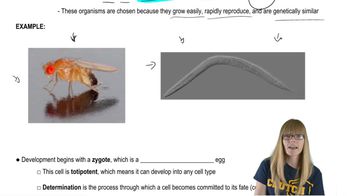Which of the follow sex chromosomes can be describes as homogametic?
Table of contents
- 1. Introduction to Genetics51m
- 2. Mendel's Laws of Inheritance3h 37m
- 3. Extensions to Mendelian Inheritance2h 41m
- 4. Genetic Mapping and Linkage2h 28m
- 5. Genetics of Bacteria and Viruses1h 21m
- 6. Chromosomal Variation1h 48m
- 7. DNA and Chromosome Structure56m
- 8. DNA Replication1h 10m
- 9. Mitosis and Meiosis1h 34m
- 10. Transcription1h 0m
- 11. Translation58m
- 12. Gene Regulation in Prokaryotes1h 19m
- 13. Gene Regulation in Eukaryotes44m
- 14. Genetic Control of Development44m
- 15. Genomes and Genomics1h 50m
- 16. Transposable Elements47m
- 17. Mutation, Repair, and Recombination1h 6m
- 18. Molecular Genetic Tools19m
- 19. Cancer Genetics29m
- 20. Quantitative Genetics1h 26m
- 21. Population Genetics50m
- 22. Evolutionary Genetics29m
3. Extensions to Mendelian Inheritance
Sex Chromosome
Problem 1d
Textbook Question
How do we know that X chromosomal inactivation of either the paternal or maternal homolog is a random event during early development in mammalian females?
 Verified step by step guidance
Verified step by step guidance1
Understand the concept of X-chromosome inactivation: In mammalian females, one of the two X chromosomes in each cell is randomly inactivated during early embryonic development to ensure dosage compensation. This process is known as Lyonization.
Recognize the experimental evidence: Scientists have studied X-chromosome inactivation by analyzing the expression of genes on the X chromosome in female cells. They observed that some cells express genes from the paternal X chromosome, while others express genes from the maternal X chromosome.
Learn about the use of genetic markers: Researchers use genetic markers, such as polymorphisms or mutations, to distinguish between the maternal and paternal X chromosomes. By analyzing these markers in different cells, they can determine which X chromosome is active in each cell.
Understand clonal analysis: During development, cells divide and form clones. If X-chromosome inactivation were not random, all cells in a clone would express the same X chromosome. However, studies show that cells within a clone can express either the maternal or paternal X chromosome, supporting the randomness of the process.
Review studies on mosaicism: Female mammals are genetic mosaics for X-linked traits due to random X-chromosome inactivation. For example, in calico cats, the random inactivation of X chromosomes carrying different coat color genes results in the characteristic patchy fur pattern, providing visual evidence of the randomness of this process.
 Verified video answer for a similar problem:
Verified video answer for a similar problem:This video solution was recommended by our tutors as helpful for the problem above
Video duration:
1mPlay a video:
Was this helpful?
Key Concepts
Here are the essential concepts you must grasp in order to answer the question correctly.
X Chromosomal Inactivation
X chromosomal inactivation is a process in female mammals where one of the two X chromosomes is randomly silenced during early embryonic development. This ensures dosage compensation, balancing the gene expression between males (XY) and females (XX). The inactivated X chromosome forms a structure known as a Barr body, which is not expressed in the cell.
Recommended video:
Guided course

X-Inactivation
Random Selection
The random selection of which X chromosome to inactivate occurs early in development, meaning that in a female's cells, some will express genes from the paternal X chromosome while others will express genes from the maternal X chromosome. This randomness leads to a mosaic pattern of gene expression, which can be observed in traits such as coat color in calico cats, where patches of color correspond to the inactivation of different X chromosomes.
Recommended video:
Guided course

Non-Random Mating
Evidence from Genetic Studies
Genetic studies, including those involving genetically modified mice and human cell lines, have provided evidence for the random nature of X inactivation. For instance, experiments that track the inheritance of traits linked to X chromosomes show that the inactivation pattern is not biased towards either parent, supporting the idea that the process is random and occurs independently in each cell during early development.
Recommended video:
Guided course

Genetics of Development
Related Videos
Related Practice
Multiple Choice
583
views
5
rank


